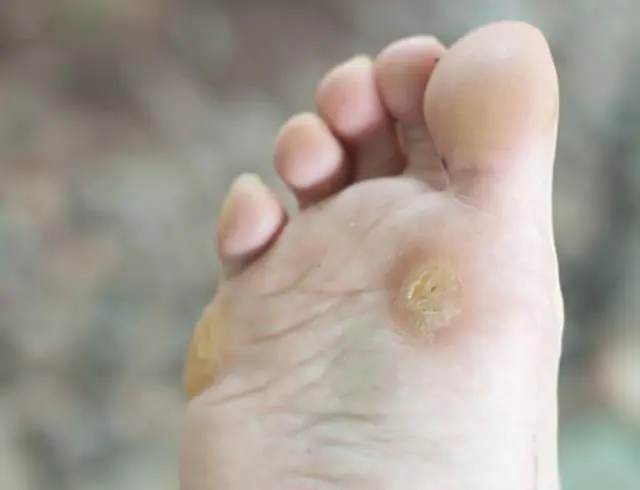
- Ways of infection with the virus
- What do papillomas on the foot look like?
- Diagnostic methods
- Treatment with medications
- Removal of papillomas on the feet
- Electrocoagulation
- Radio wave destruction
- Laser removal
- Cryodestruction
- Surgical intervention
Papillomas on the foot (plantar warts) are neoplasms on the human body, the appearance of which is caused by the activity of the papilloma virus. The growths in this case are located on the sole and toes. The disease is quite common, but it is difficult to treat, and the recovery process can be delayed.
Ways of infection with papillomavirus on the foot

Infection with HPV strains that affect the skin on the soles of the feet can occur in public places such as baths, saunas, showers, and swimming pools, where people walk barefoot. It is also easy to catch the causative agent of papillomatosis when wearing someone else's shoes, even if this happens only once.
Note! Most easily, the virus that provokes the appearance of papillomas on the foot enters the body through damage to the body: microcracks, scratches, cuts, unhealed wounds.After HPV enters the human body, small growths with rounded outlines appear on the foot. And, despite the fact that such formations are benign and do not pose a threat to life, they begin to grow deeper into the epithelium, causing great discomfort.
Papillomavirus types 1, 2, 3, 4, 27, 29 and 57 are localized on the foot. These strains of HPV are very fond of heat and high humidity, against the backdrop of this, it would seem that beaches are an ideal place to catch an infection. However, this opinion is wrong, because When exposed to direct sunlight, the virus dies.
HPV, which causes the appearance of papillomas on the foot, can be infected by anyone, regardless of their gender and age. However, it should be noted that people who are more prone to this are:
- have a weakened immune system;
- neglect to observe the rules of personal hygiene;
- often wear closed, tight shoes;
- have increased sweating of the feet;
- suffer from diseases such as diabetes, arthrosis, arthritis, varicose veins;
- are exposed to frequent and prolonged stress.
What do papillomas on the foot look like?
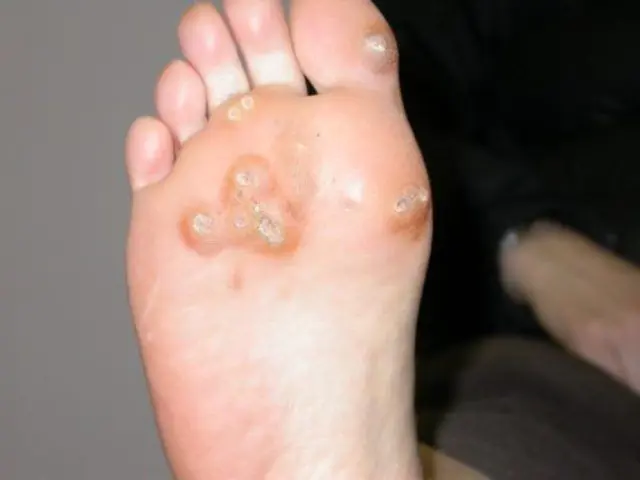
The photo shows mosaic papillomas on the foot
In order to select the appropriate treatment for papillomas on the foot, it is important to make a timely and correct diagnosis. Often, patients do not pay due attention to the formations that appear on their legs, mistaking them for corns and calluses.
Indeed, at first glance you can be mistaken, because calluses, corns, and papillomas are compactions shaped like a circle or an oval. The sizes of such seals vary from a couple of millimeters to several centimeters. However, this is where the similarities end.
At the initial stages, papilloma on the foot has a pinkish color, but over time the growth becomes coarser and becomes rough to the touch, the color changes to yellow and then gray-brown.The roots of a plantar wart penetrate deep into the epithelium, which is why a person may feel severe pain when walking or pressing on the lesion. The roots may not be visible immediately; the reason for this is the hardened layer of skin above the wart.
Therefore, first you need to thoroughly steam your feet in a soda-saline solution, carefully remove the keratinized skin layer in order to examine the papilloma on the foot and its core - a black dot, which is equipped with blood vessels.
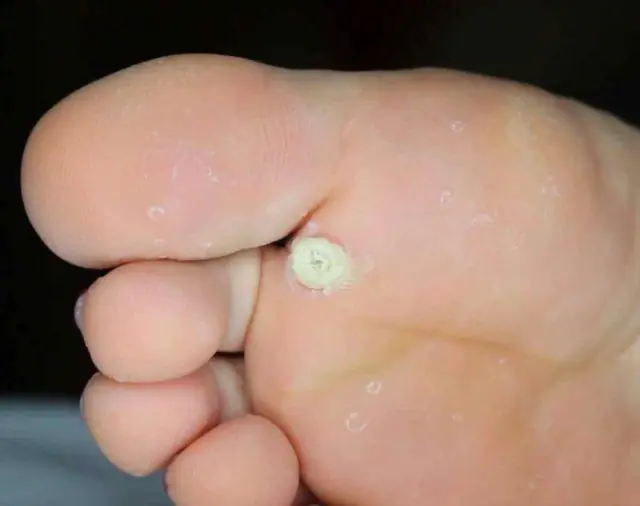
Photo of a deep plantar wart
Formations caused by the human papillomavirus, which affects the skin on the foot, are of two types:
- Mosaic warts are several growths fused together, in most cases they are localized on the forefoot.
- Deep palmoplantar warts are single papillomas.
If the disease is not diagnosed on time and the necessary therapy is not started, the warts will spread further to healthy skin, forming entire chains of papillomas. It is especially common to find multiple formations on the toes and between them, but on the heels the growths may not grow.
Papillomas on the feet do not appear immediately after the virus enters the human body. The patient can detect them several weeks or even months after infection.
Methods for diagnosing papillomas on the feet
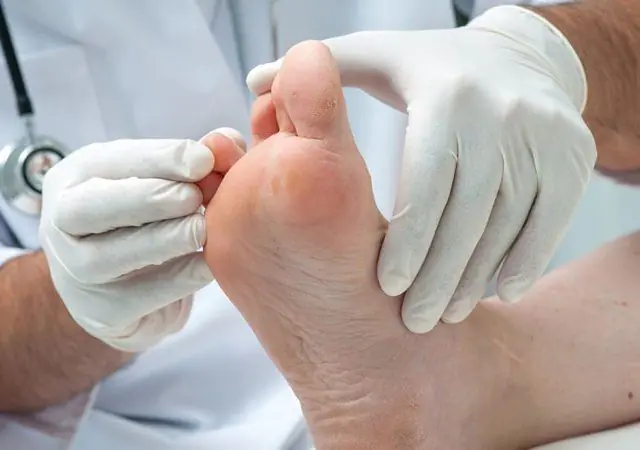
If you are still unable to independently distinguish calluses, heel spurs and corns from papillomas formed on the soles of your feet, or you are simply concerned about a growth on the sole of your foot, seek help from a qualified medical professional. In your situation, a dermatologist will come to the rescue.
To make an accurate diagnosis, you will have to carry out dermatoscopy - a procedure with which you can examine microscopic areas of the skin, identify the etiology of the formation that has arisen, and also assess whether it poses a threat to the patient’s life. With the help of dermatoscopy, it is easy to detect even melanoma at the earliest stages, which allows timely treatment to begin.
In addition, to identify papilloma on the foot, the patient is required to take additional lab testswhich will allow you to determine the patient’s immune status, you may need to contact an immunologist.
Also, the attending physician can prescribe a diagnostic method Polymer chain reaction. To do this, it is necessary to examine the patient’s urine and blood using a special reagent. PCR analysis allows you to accurately determine the specific strain of papillomavirus that parasitizes the foot.
In some cases, in patients who have a fairly strong immune system, warts go away on their own, leaving no traces. However, the percentage of people infected with HPV who managed to get rid of papillomatosis without involving a dermatologist hardly reaches 20%.
Attention! If you notice that formations that previously did not bother you began to bleed, turned red, began to peel off, suppuration appeared, the shape and size of the growth changed, or you feel itching that was not there before, consult a doctor immediately!Treatment of papillomas on the foot with medications

The photo shows medications for the treatment of papillomas on the foot
If the disease is not too advanced, then treatment of papillomas that have formed on the foot should begin with drug therapy. In many cases it turns out to be quite effective and can give good results.
First of all, the doctor prescribes drugs that stimulate the immune system and also prescribes antiviral drugs. The most effective drugs for getting rid of plantar warts are:
- Viferon. Activates the immune system and protects the body from hidden infections. It is used before and after surgical removal of growths. The price of Viferon for papillomas on the feet is from 300 rubles. If desired, you can resort to its analogues: Kipferon, Reaferon-EC, Altevir.
- Oxolinic ointment. It affects epithelial cells at the site of virus reproduction, preventing it from spreading further. To get rid of papilloma on the foot, you should use only a three percent ointment, because with a weaker concentration of active substances, the drug is not able to cope with HPV. The medicine is applied to the affected area three times a day for 14 days to 2 months. If after this time the therapy has not produced results, it is necessary to resort to more radical measures. The price of oxolinic ointment is from 50 rubles. It is possible to use such substitutes as Vartek, Alpizarin, Amiksin.
- Aldara. Stimulates the body to produce interferon and also blocks the development of tumors. The medicine should be applied to the papilloma on the foot before bed and not washed off for at least 8 hours. The price of the drug is from 4500 rubles. Imiquimod, Keravort can replace the medicine.
- Panavir. A herbal preparation that can suppress viral activity, as well as block the formation of infection proteins, preventing it from spreading to healthy areas of the skin. It has several forms of release: spray (from 317 rubles), rectal suppositories (from 1500 rubles), gel (from 150 rubles), injection solution (from 1500 rubles). Analogues of the drug are Acyclovir, Fenistil, Vivorask.
In addition to the remedies described above, for the treatment of papillomas on the foot, you can use alkalis and acid solutions, such as Wartner, Supercleaner, as well as iodine solution, Lapis pencil and Verrukatsid for papillomas. These remedies actively fight the external manifestations of papillomavirus, relieving the patient of tumors on the legs, but are not effective against the infection itself; it continues to live in the body.
It is important to know! For productive treatment of HPV, not only drug therapy should be used, but a comprehensive approach to the virus. In addition to the use of medications, it is also necessary to take care of a balanced diet and the correct balance of physical activity and rest.- Read the instructions for use of Antipapilloma for papillomas and warts
Methods for removing papillomas on the feet
Depending on the degree of neglect of the disease, as well as taking into account the speed at which it progresses, the dermatologist can offer a choice of one of the radical ways to combat papillomatosis.
Electrocoagulation for removal of papillomas on the foot

The photo shows how papilloma on the foot is removed using electrocoagulation
A contraindication for such a procedure may be the suspicion of degeneration of papilloma on the foot into a malignant formation. However, if all tests are normal, electrocoagulation can be safely performed.
This method of removing warts involves applying a current charge to the affected areas. The choice of nozzle for the device, as well as the frequency and current strength, depends on the size, shape and density of the growth.
The procedure prevents secondary infections from entering the wounds; after the end of the session, the skin is treated with a special antiseptic solution. This method is recognized as relatively inexpensive and very effective, as well as safe.
If papillomas have grown significantly on the foot, then more than one procedure may be required. Electrocoagulation may have to be carried out several times over a short period of time, preferably every other day.
In Russia, the price for removing one wart is from 800 rubles; if there are more than 30, the price will reach 12,000 rubles. In Ukraine - from 250 hryvnia for one education.Radio wave destruction of papillomas on the foot
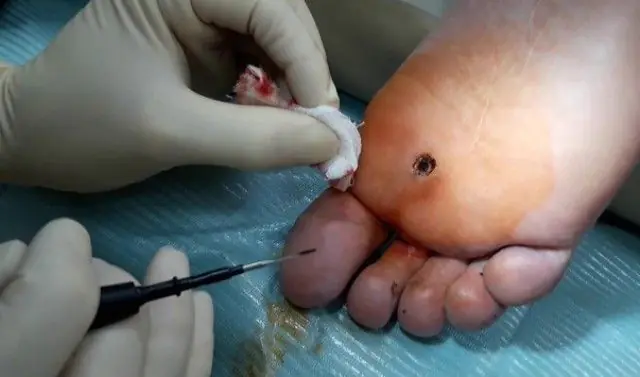
This is a hardware procedure, and it is most effective in the initial stages of the disease. The process of removing papillomas on the foot is bloodless, since at the same time the blood vessels are soldered together.
Radio wave destruction is contraindicated:
- Pregnant women;
- For mothers during breastfeeding;
- Patients suffering from diabetes mellitus;
- Patients with malignant tumors of any location.
Also, the procedure should be postponed in case of exacerbation of herpetic infection and inflammation of the skin.
Removal of papillomas on the foot using radio waves is allowed even for children; there are no age restrictions.
Before the procedure, the patient is given an anesthetic, then using a loop electrode through which high-frequency radio waves are passed, the tumor tissue is exposed. The intracellular fluid evaporates, and the wart tissue is destroyed and dies. The procedure lasts about 10-18 minutes; upon completion, the skin is treated with an antiseptic.
After the procedure for removing papillomas on the foot, you should temporarily refrain from taking hot baths, visiting pools and baths, avoid direct sunlight, and also refrain from going to the solarium. These rules should be followed for at least 2 weeks after the session, and the removal sites should also be regularly treated with antibacterial and antiseptic agents.
To remove one papilloma using this method costs about 1 thousand rubles in Russia and 400 hryvnia in Ukraine.Laser removal of papillomas on the foot
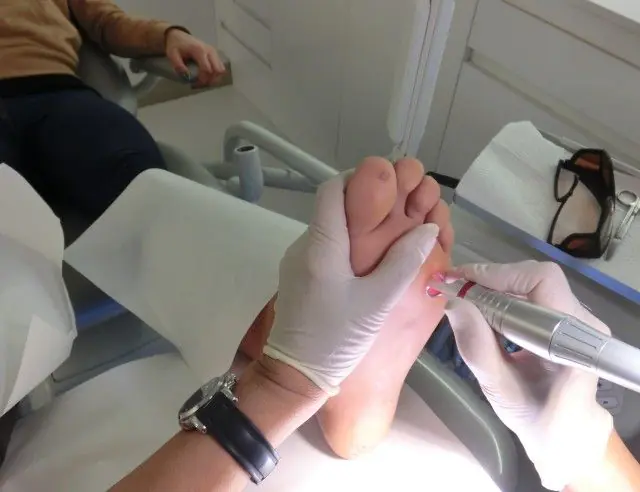
The photo shows the process of removing papilloma on the foot with a laser
With the help of laser radiation, you can easily and quickly deal with the problem of warts on the legs and body. During the procedure for removing papilloma on the foot, the temperature in the damaged tissues rises sharply, which leads to the evaporation of infected cells.
There are two types of lasers:
- With constant radiation. It is not advisable to use it on the face and neck, since such removal will certainly leave a scar, the size of which is directly proportional to the removed wart.
- Fractional laser. The beam works in pulses; in one pass, the laser affects only the top layer of skin, leaving no scars.
Judging by numerous photos on the Internet, removal of papillomas localized even on the foot occurs in 1 session and does not leave blisters on the skin.
Laser destruction takes an average of 7 minutes, but the irradiation site should first be anesthetized. During the procedure, both the patient and the doctor must wear special glasses that will protect the retina from laser beams.
After the growth is removed, the burn site is treated with any antiseptic and sealed with an adhesive plaster.
Removal of papillomas on the foot is contraindicated for cancer patients, patients with high blood pressure, a temperature above normal, and people suffering from herpes.
In Ukraine, the cost of removing one growth is 350 hryvnia, but if there are 20 to 50 tumors, then the price for such a procedure will be from 3000 to 4000 hryvnia. In Russian medical centers, this type of papillomas removal is also not cheap - from 1800 rubles per wart.Cryodestruction of papillomas on the foot

This procedure is the process of exposing pathological cells to low temperatures. The method is based on freezing water from the intercellular space using liquid nitrogen.
The method is quite popular and especially effective against papillomas on the foot with deep roots.
Cryodestruction is contraindicated in case of individual intolerance to liquid nitrogen, in pathological processes in the body, and also if there is a high level of probability of degeneration of a benign formation into oncology. Diabetics are not allowed to use the freezing method.
The cost of such a procedure will depend on the number of papillomas on the foot to be removed. To get rid of one wart in Russian clinics costs about 1 thousand rubles, if there are more than 20 warts, then the price will be approximately 8-12 thousand rubles. In Ukraine, specialists also carry out similar procedures; removing one wart costs from 150 hryvnia.Surgical intervention for papillomas on the foot
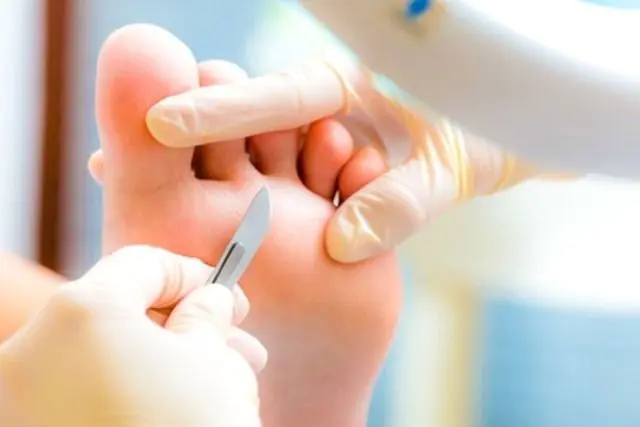
The most proven method of all described. It is prescribed if papilloma on the foot causes excruciating pain when walking, has changed shape, is very itchy, if the area of tissue damage is quite extensive.
This is the only method that allows the elimination of formations that have degenerated into malignant ones. After the operation, the removed areas are sent for subsequent histological examination.
Surgery is prohibited if the patient has a cold or has other untreated infections, including herpes. Pregnant and lactating women should also refrain from surgical removal of papillomas on the foot.
Ukrainian specialists remove one plantar wart at a price of 320 hryvnia, while in Russia it costs an average of 900 rubles.You should not start the problem or try to get rid of it yourself. A timely visit to a dermatologist will reduce the risk of a benign tumor turning into melanoma and save your life!
How to remove papillomas on the foot - watch the video:
[media=https://www.youtube.com/watch?v=FuN8kG4mphU]
Do not neglect preventive measures. In swimming pools and saunas, use disposable slippers or specially brought ones with you. Do not wear someone else’s shoes; try them on in shoe stores only after putting a sock on your foot. If cracks and wounds appear on your feet, use healing creams, this will help prevent the pathogenic virus from entering the body.
- Related article: ways to use celandine oil for papillomas



